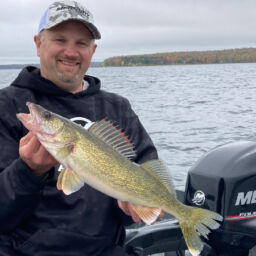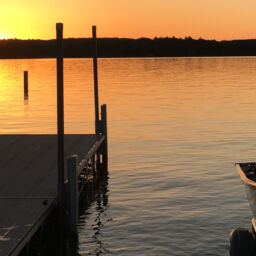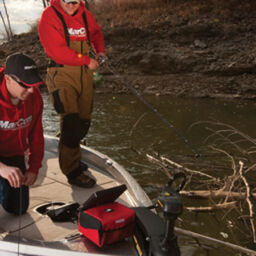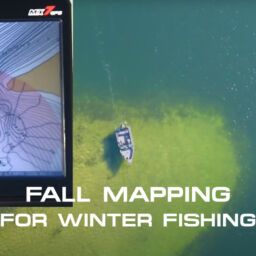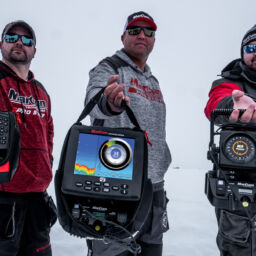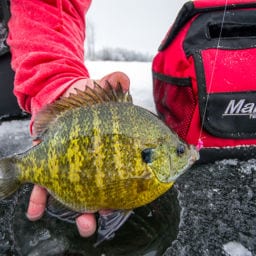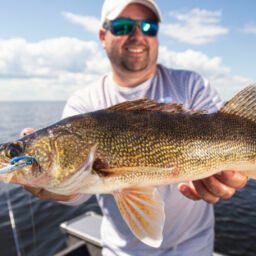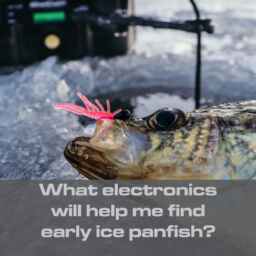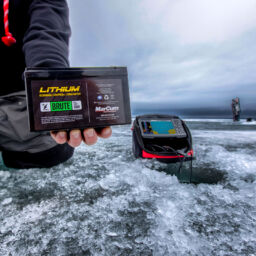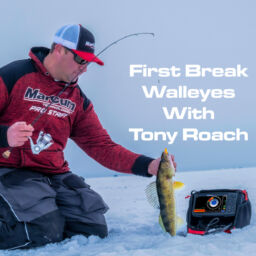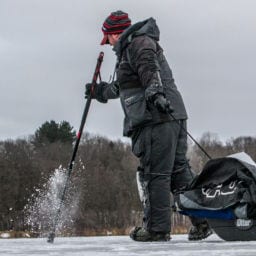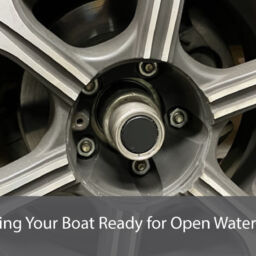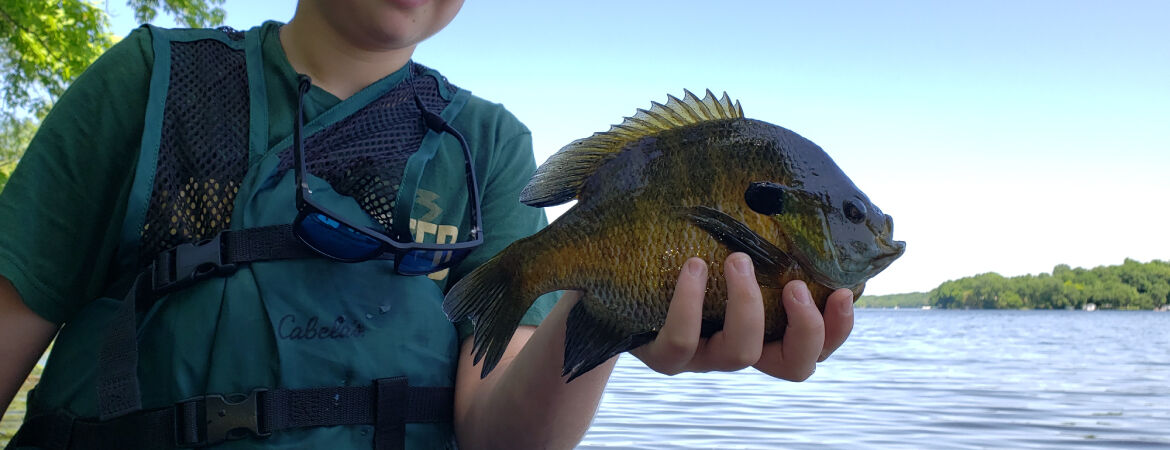
Pre and Post Spawn Panfish Patterns
If you’re a crappie angler, one of the best bites of the year has come and gone with the early spring crappie bite. For bluegill fans, the best is yet to come, as we move from a shallow water period for one species into another.
There’s no doubt that the spawning season for crappies and bluegills offer some great opportunities for skinny water panfishing, and even sight fishing, which makes fishing feel like it did when you were a kid.
Bobbers and small jigs are plopped into any good looking developing weeds or brushy areas, only to drop with an aggression not seen since the previous year’s fishing. It’s hard not to be excited about it.
Crappies Push Out
Yet, for all the fun that can be, each species has some great fishing to come, whether your favorite has spawned or not. With crappies, the game becomes post-spawn, and finding fish that are setting up for their summer patterns.
So often, no matter the locale, that involves some weedlines and fairly predictable crappie fishing once they’re found. That can mean anything from fish on the edge of lily pads which hang out under overhead cover by day, only to roam new cabbage growth by evening, to deeper crappies relating to the base of weedlines, eating bloodworms in the mud.
Either way, at least for crappies, it’s time to start looking immediately outward from where they were, and stop fishing fond memories in shallow reeds or black bottom bays. That’s where electronics come in handy, both to find weedlines, and to mark them on sonar/gps combos like the MarCum MX-7GPS.
Fish will either hang out on the edge, or bury themselves on weedy flats that have great cabbage or coontail. Either way, some of the best fishing can be towards dark when crappies actively feed, either up or down.
In weedy flats situations, it’s hard to beat small twister tails, tubes, and other plastics with 1/32 oz. – 1/16 oz. jigs just slowly rolled near the tops of quality aquatic vegetation. It can be as simple as letting the boat drift along, fan-casting, and slowly reeling your way around all portions of the flat.
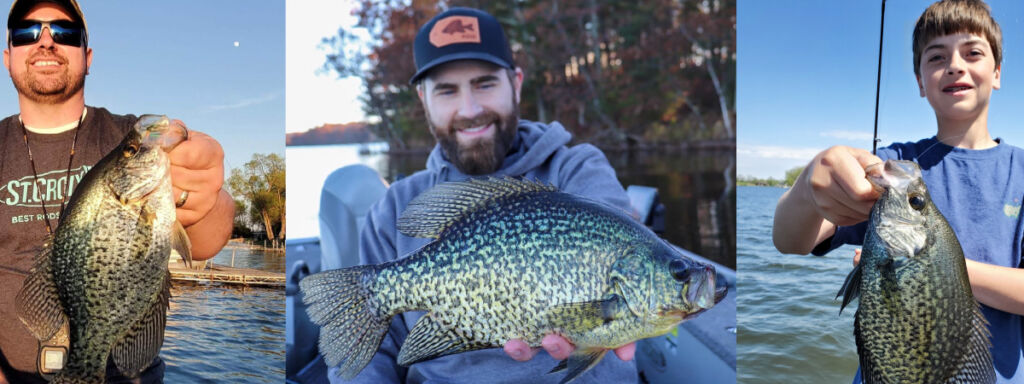
Typically, you’ll find certain areas of the flat to be more productive, either the shallow side or deep side, with sparse growth or edges of dense growth, so you’ll want to observe where the most bites are coming from. That pattern becomes one then that you’ll look to replicate throughout the lake as you fish around other flats as well.
Of course you can also pull the same jig and plastics combinations under boat power in the form of jig trolling. It’s a proven technique for presenting baits at set locations in the water column, allowing anglers to hold steady, readying themselves for a bit so they can set the hook.
Typically, anglers mix and match colors, weights, and jig or plastic types to maximize the searching power of their offering, then let the fish tell them what to focus on the most. Whether trolling or casting and reeling through these areas, it’s typically more effective to maintain a steady retrieve at a singular depth than bounce or jump jigs up and down. Crappies have an easier time tracking baits from below and behind under steady motion than those that hop.
Bluegills Move In
The more evenly spaced and distributed crappie beds now give way to dense clusters of nearly-touching bluegill spawning beds in the shallows of your favorite lake. Gills tend to start nesting in water temps that approach 70 degrees towards the end of May and into June for many northern waters in the upper Midwest.
With any water clarity at all, it’s easy to spot beds in depths below 5 feet, though bluegill beds can be as deep as nearly 10 feet, with more and more fish spawning on offshore structures than we ever thought before. Whether deep or shallow, these bedding fish concentrate the majority of the fish in the lake to smaller areas than they usually roam or inhabit during the rest of the open water period.
Yet, like so many seasonal high-points in the fishing action, the net result is often a period of high exploitation of the resource. It’s why some folks won’t target any species during the spawn, especially when they’re visibly guarding nests and going about their biological business. Truly, their vulnerability brings about our opportunity, or does it? Long term, the effects of overharvest, specifically of large bluegills has been well studied.
In a particularly revealing study from the Park Rapids, MN area (Olson and Cunningham, 1989), big fish contest entries from the local paper were examined over a 58-year period for panfish. Research showed a strong decline in average weight of both black crappie and bluegill species over each decade that the contest took place up to current day.
If you look at the MN records for both of these species, you see they’re both from the 1940’s. Over-harvest is the likeliest culprit as to why we are where we are today, as angling pressure both in terms of effort and technology have only increased despite the lowering of limits, including special regulations for some lakes.
How can we make a difference? Purely and simply by releasing big male bluegills. Here are a few well-studied fisheries truths to that very point. “Large parental males protect nests, sexually mature at 7-8 years (Gross, 1982), and grow faster. Cuckolder males sneak in to fertilize, provide no parental care, grow slowly, die young, and sexually mature in 4-5 years (Mackenthun, 2012).”
Males are often identified with a larger ear tab and brighter spring spawning colors, while females have a yellowish, almost drab appearance. Their ear tabs are shorter than their male counterparts, and while they certainly serve to drop eggs on the beds, their harvest doesn’t as readily contribute to the problem of cuckolder males and stunting.
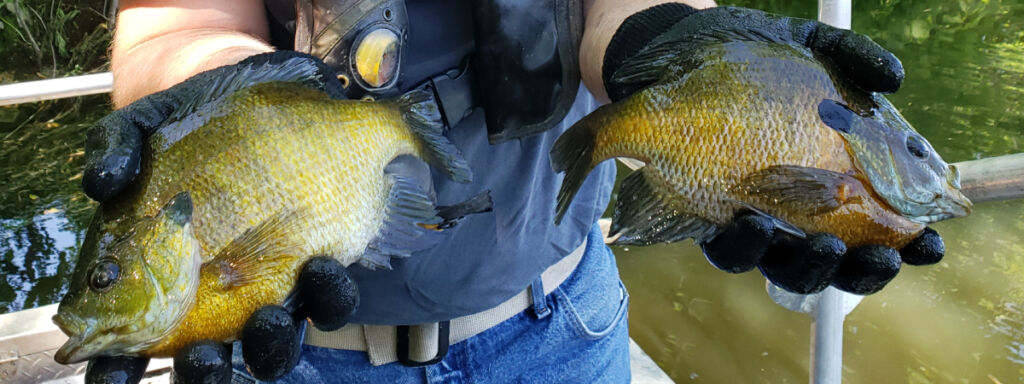
Both sexes are easily targeted with small jigs of any kind, sporting live bait or plastic. More often, it’s a matter of properly setting bobbers so both the depth and speed are dialed. Depth is important such that you’re dangling your offering in front of fish, rather than above or below, and speed is important as it often takes a slow fall, rather than fast retrieve, to get fish to commit. Plain hook and worm combinations with no weight below a bobber are especially effective, especially for the fish guarding nests.
That said, with the biggest males in the lake being up on beds, willing to hit most anything presented properly, this is one of the most vulnerable periods possible for overall health of the bluegill fishery in any lake you choose to fish.
Please release these fish to carry on their duties, and be around for all of the other times of year you choose to fish them. Not only does overharvesting reduce the overall high end size of bluegills in any given lake, it can genetically push down those upper limits for years to come, affecting the upper end potential for that lake moving forward. Irreparable damage can be done if we’re not careful as anglers.
Looking for other ways to have your fish and eat them too? We know to release the big males, but we can also avoid high-grading the largest of the large as mentioned. Even better, vary your take from a number of lakes if you enjoy eating bluegills.
Though it’s tempting to park on community beds, challenge your fishing skills and look to figure out fish on a variety of waters. It not only makes you a better angler, but it spreads your take.
Finally, consider giving them a break altogether, especially if others in the area aren’t. A race to consume resources only results in hurting the population and our fishing of it both. It’s something to pass on to your kids, nephews and nieces, and young cousins alike.
“Do as I say, AND as I do.” Lead by example by enjoying fish as a treat, measuring them to get an idea of what a big gill really is, and focusing on the experience more-so than filling the freezer. It’s the surest way for our children to enjoy these great fish as much as we do.
Resources:
Gross, M.R. 1982. Sneakers, satellites, and parentals – polymorphic mating strategies in North American sunfishes. Zeitschrift fur Tierpsychologie 60: 1-26.
Olson, D.E. and P.K. Cunningham. 1989. Sportfishing Trends Shown by an Annual Minnesota Fishing Contest over a 58-Year Period. North American Journal of Fisheries Management 9: 287-297.
Mackenthun, Scott. MNDNR Area Supervisor – Hutchinson, MN. 2012. Big bluegill seminar and discussion interview.



